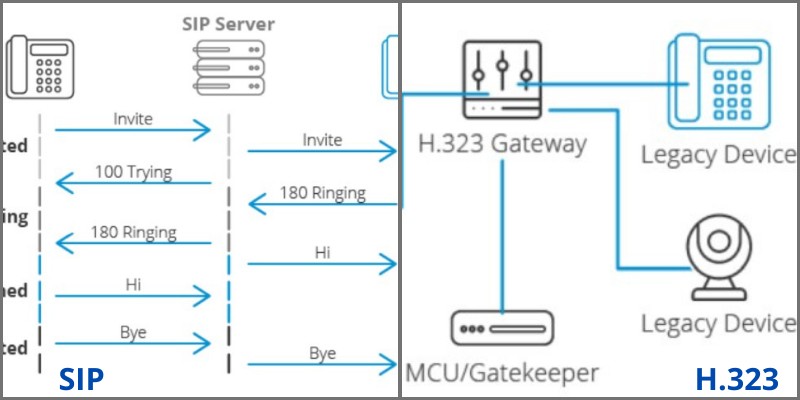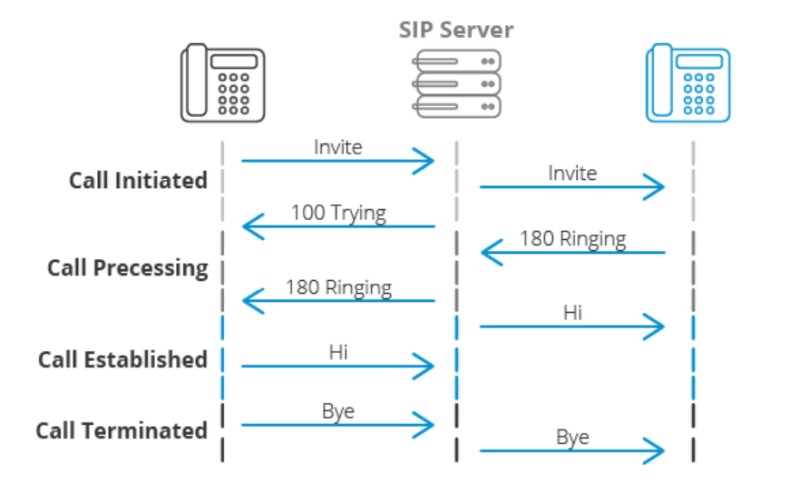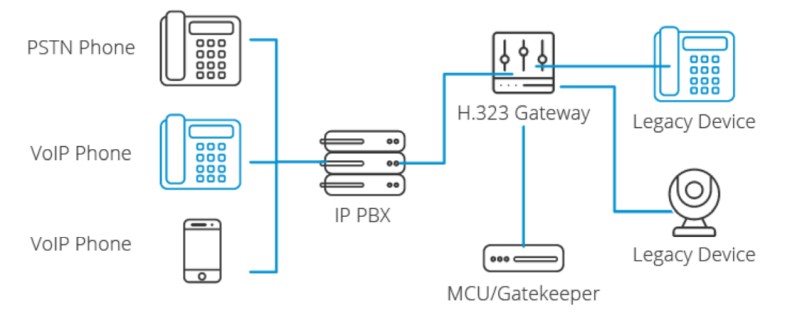Voice over IP (VoIP) is a technology that allows you to transmit voice over an IP network. This enables both telephony and data to be transmitted over the same network packet-based infrastructure.

There are two fundamental protocols used to transmit the signaling that is necessary to make IP telephony operate correctly. These protocols are Session Initiation Protocol (SIP) and H.323.
These are two very different protocols that emerged from very different beginnings. In this article, we’ll examine them more closely to understand how they operate and where they are typically employed.
So, let’s discuss and compare SIP vs H323 starting with a high-level comparison table:
H323 vs SIP – Comparison Table
The following table compares the H.323 and SIP protocols:
| Description | SIP | H.323 |
| Origins | IETF Internet based | ITU-T based on ISDN |
| Routing architecture | Flat | Hierarchical |
| Control Systems | SIP server/IP PBX, mandatory | Gatekeeper, optional, but necessary for larger deployments |
| Endpoint addressing | Uses SIP URLs | Uses aliases mapped by Gatekeepers |
| Natively compatible with IP and the Internet | Yes | No |
| Design | Modular flexible | Monolithic, inflexible |
| Additional features | Instant messaging, presence | None provided beyond voice and video |
| Interoperability with traditional telephony | Not readily interoperable but can be implemented with appropriate adaptors/voice gateways | Backward compatible |
VoIP, IP Telephony, and Signaling
In order to understand SIP and H.323, as well as their differences and operation, let’s take a brief look at what VoIP is and what role it plays in IP telephony.
VoIP
VoIP is a set of technologies and methodologies that digitizes and packetizes voice at the source device and prepares it to be sent over the network in the form of IP packets.
These packets are received and reassembled at the destination device and the original voice is reproduced and heard by the receiver.
IP telephony leverages VoIP to enable users to call each other using the well-known process of picking up the handset of a phone and dialing a number.
Signaling
Like traditional telephony, IP telephony requires signaling mechanisms. Signaling is involved in initiating, maintaining, modifying, and terminating a call.
When you pick up the handset of a phone, the phone goes off-hook which sends a signal. Dialing numbers send signaling to the server responsible for routing telephone calls.
Functions such as making a phone ring, hearing ringtone, dialing a number, implementing call display, call waiting, call hold, and various other advanced telephony features, all use signaling to successfully operate.
Signaling is achieved in conventional telephony using a physically separate data channel. For VoIP and IP telephony, signaling is achieved using protocols such as SIP and H.323 that create communication sessions between devices that are separate and distinct from the actual exchange of voice packets.
Session Initiation Protocol (SIP)
History
SIP was conceived quite early on in 1996 and by 1999 it was published as a standard by the Internet Engineering Task Force (IETF) in RFC 2543.

The goal of its founding developers and of the standardization organization that has adopted it since has been to provide a signaling and call setup protocol for IP-based communications that can mimic and reproduce the call processing functions and features of the Public Switched Telephone Network (PSTN).
At the same time, SIP was designed to be extendable to support additional multimedia services such as video conferencing, and media streaming as well as specialized functionalities that include presence, instant messaging, file transfer, fax over IP, and even online gaming.
Born out of the Internet
Unlike other telephony protocols, SIP is lauded by its proponents for having roots in the Internet community rather than the telephony industry.
This is demonstrated by the fact that SIP has been standardized by the IETF whereas other voice protocols such as H.323 and ISDN have been traditionally associated with the International Telecommunications Union (ITU).
SIP, as its name suggests, is involved in the control mechanisms related to the initiation and termination of sessions needed to allow voice and video applications to function.
It defines the format of the control messages (and once again, not the voice packets) transmitted between participants in a media exchange.
Call setup, call teardown, and Dual Tone Multi-Frequency (DTMF) signals are just some of the call control messages that SIP transmits.
These are among the features that have been employed in traditional telephony for decades that SIP essentially duplicates within the VoIP domain. SIP was designed to mimic the functionality of the PSTN and conventional PBXs to avoid the need of retraining users when moving from conventional to IP telephony.
The goal was to allow a user to use a SIP-enabled telephone without any change in the tones, functionality, and general feel of the calling experience that users have become so familiar with over the years.
An advanced protocol
Even so, SIP was designed to be modular and flexible, to be able to deliver much more than what the traditional PSTN offered.
This modularity allows sip to continually be developed to incorporate advanced features and functionalities that take advantage of the IP infrastructure upon which SIP is based.
VoIP systems based on SIP can easily expand VoIP network services by adding video and mobile users to their existing infrastructure with very little intervention into the existing system.
This increases the options an organization is provided with, as the addition of features is often implemented by simply obtaining a license, a software package, or a system server, depending on the type of feature in question.
H.323 VoIP Protocol Suite
History
The most popular alternative signaling protocol to SIP is H.323 which was developed by the ITU-Telecom Standardization Sector (ITU-T).

Although it can be used for strictly voice conversations, it is most often applied today in video conferencing equipment and leverages the Q.931 standard, which defines legacy ISDN circuits.
The original intention was to allow video conferencing systems to use ISDN infrastructure which seemed to be a very promising technology at the time, although it has since been adapted to run over IP networks as well.
Protocol Suite
H.323 is more properly referred to as a system specification or standard that includes various protocols providing multiple services. These protocols are further described below:
H.225.0 Call Signaling – This is essentially SIP’s counterpart as it is the fundamental signaling protocol in the H.323 suite.
H.245 Control protocol – This protocol standardizes the methodology of the exchange of capability information between endpoints and opens and closes logical channels for voice and video.
H.225.0 Registration, Admission and Status (RAS) – This feature is unique to H.323 in that it doesn’t have a counterpart in a SIP environment. Where SIP is highly flat in its architecture, the H.225.0 RAS protocol provides a hierarchical structure to call signaling, with a device called a Gatekeeper at its center. This is especially useful for large enterprises with multiple campuses, locations, and branch offices requiring a centralized and interconnected telephony network.
Conclusion
As all communications systems are slowly converging towards leveraging a single IP-based communication infrastructure, SIP is quickly becoming the protocol of choice.
More and more businesses, vendors, and providers are adopting the use of SIP in their telephony and telecom infrastructures. H.323, although still prevalent, is slowly waning.